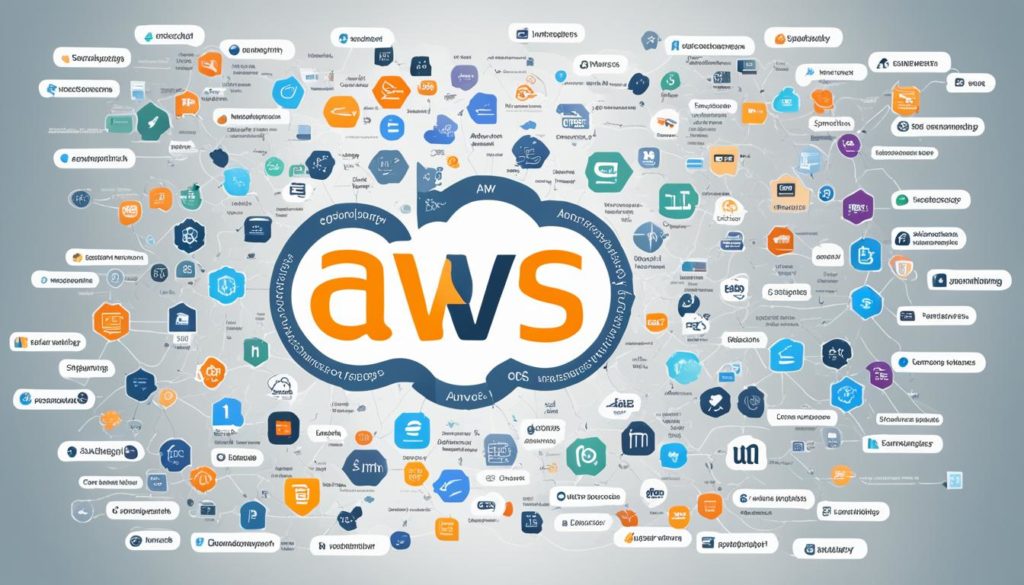
AWS isn’t just big; it offers twelve programming languages for developers. Mastering programming languages on AWS, can be daunting. From the well-known C++ to the new Rust, it paves the way for innovation in cloud computing. By diving into cloud potential, developers find a treasure trove. It includes AWS SDKs, helpful documentation, and sample code. Mastering Programming Languages AWS involves using a system designed for AWS-friendly programming. This system is supported by top-notch Integrated Development Environments (IDEs).
In the AWS development world, picking the right programming language is crucial. It’s like finding the key that unlocks seamless integration and easy coding. AWS Cloud9, Eclipse Toolkit, and Visual Studio Code are among the IDEs available. They help developers build, debug, and launch applications for the vast cloud.
Key Takeaways
- Choosing the right programming language is crucial for tapping into AWS’s full visual.
- AWS supports a wide range of programming languages, ensuring there’s a fit for every developer.
- Specific AWS SDKs are available for each programming language, providing necessary tools and resources.
- IDEs like AWS Cloud9 and Visual Studio Code enhance the AWS-compatible coding experience.
- Each language and IDE combination on AWS is backed by robust documentation and community support.
- Efficient deployment on AWS hinges on the powerful integration of IDEs and AWS SDKs.
Exploring the Ecosystem of AWS Programming Languages
AWS holds a rich ecosystem of AWS programming languages at its core. These languages are well-supported through AWS SDK supported programming languages and various IDEs. They help us build and manage applications smoothly. Let’s look into what these languages offer and how they help innovate in the cloud.
AWS supports languages like C++, .NET, and Java, and also newer ones like Kotlin and Swift. These languages are part of the AWS certified programming languages for their reliability, community support, and versatility. AWS has the tools you need, whether it’s for a mobile backend, a cloud-native app, or system integration.
- C++: Known for its performance in system-level programming.
- Java: Widely used, object-oriented, and has vast open-source support.
- Python: Loved for its easy-to-learn syntax and powerful libraries.
- Ruby: Appreciated for its elegant syntax that’s ideal for quick development cycles.
- Go: Praised for its simplicity and efficiency in concurrent processes.
Using these languages in the AWS ecosystem boosts developer abilities. AWS Cloud9 and other IDEs help greatly. The IDEs complement the advanced features of AWS SDK supported programming languages. They make coding, debugging, and deploying smoother.
Integrating different languages into your AWS projects brings many benefits. It taps into AWS’s scalability and makes your applications strong, secure, and up-to-date with technology trends.
The Foundations of AWS Development: Setting Up Your Environment
Starting with AWS development means you need a good plan. Picking the best tools and languages is key for cloud success. We’ll show you the basic steps to get the best AWS development setup.
Choosing Your Preferred IDE for AWS Development
For AWS development, it’s important to choose an IDE that works well with AWS services. Top picks include AWS Cloud9, Eclipse Toolkit, and IntelliJ IDEA. These support various AWS-compatible programming languages, helping you work better and faster.
Integrating AWS SDKs with Your Development Tools
Adding AWS SDKs to your IDE is crucial. These SDKs, for languages like Java, Python, and .NET, make accessing AWS services easy. They help developers take full advantage of AWS cloud functionality.
The SDKs offer specific APIs, examples, and libraries. They are perfect for AWS development. They help you build secure, scalable apps on the AWS cloud.
Establishing Secure Access with AWS CLI and IAM Roles
Security is super important, especially with cloud services. By using the AWS CLI and setting up IAM roles correctly, you keep your setup safe. These steps also make managing AWS services simpler. They let you automate tasks and manage apps easily, especially with languages for AWS Lambda.
To wrap up, creating your AWS development environment right boosts both efficiency and security. From selecting an IDE to adding SDKs and ensuring security, these actions lay the groundwork for doing well in AWS development. As technology changes, these basic steps keep our development strong and adaptable.
Programming Languages AWS: A Deep Dive into AWS-Compatible Coding
Exploring AWS-compatible coding means we must know how AWS SDK supported programming languages help us. Languages like Node.js, C++, and Kotlin are not just supported by AWS SDKs. They are enhanced to handle complex coding tasks easily. This lets us, the developers, concentrate on making powerful and scalable apps for the AWS cloud.
Moreover, by using programming languages AWS Lambda supports, we can launch serverless apps effectively. This way is both efficient and saves money. It offers us more control over our computing resources.
For those who prefer visuals, we will look at how various AWS SDK supported programming languages work within AWS Cloud Development Kit (CDK). This kit makes managing cloud resources easier:
| Programming Language | Use Case |
|---|---|
| TypeScript | Building structured cloud applications with strong type-checking |
| Java | Enterprise-level application development |
| Python | Data analytics and machine learning projects |
| .NET | Windows-centric applications for cloud environments |
| Go | High-performance system applications |
| JavaScript | Dynamic web applications |
Companies like Culture Amp and CyberArk have made big improvements using AWS CDK. They’ve improved in setting up, working efficiently, and quick deployment. These cases show the real benefits of using programming languages AWS Lambda supports. They also show the flexibility of AWS SDK supported programming languages in different business scenarios.
To learn more about using these technologies in your next project, keep an eye out. We’ll dive deeper into making cloud applications more efficient and scalable with AWS solutions.
Best Practices for Developing with Top Programming Languages for AWS Cloud
Exploring AWS shows that picking the right AWS-compatible programming languages is crucial. With popular languages like Python and Go, our work becomes more efficient. Plus, our apps fit perfectly in AWS’s scalable space.
Writing Efficient Cloud-Native Applications
To fully use AWS’s scale and power, creating cloud-native apps is key. We choose languages for AWS Lambda and serverless tech. This lets us use microservices and stateless designs. Our apps become not just resilient but thrive in the cloud’s ever-changing scene.
Utilizing Containers and Serverless Architectures
Containers, especially Docker, have changed app deployment and management. Pairing with AWS Lambda, containers excel in automatically scaling apps by demand. This serverless method cuts down our infrastructure worries. We focus more on coding and less on server setups.
Implementing DevOps for Continuous Integration and Delivery
Adopting DevOps boosts deployment speed and reliability on AWS. It revolves around continuous integration and delivery. This fast-tracks updates. By combining AWS-certified languages and tools into our work, processes become streamlined. Automation shortens our software’s time to market.
Building and Scaling Applications with Popular Coding Languages for AWS
When we discuss creating strong apps, picking the correct AWS programming languages makes this easier. Popular coding languages like Java, Python, and Ruby stand at the core of successful cloud app development. These languages get strong backing from AWS’s vast tools and documentation, aiding developers in making scalable solutions that grow with the company.
Java leads with its write-once-run-anywhere approach, fitting well into AWS for its broad ecosystem and smooth AWS SDK integration. Python shines in data analytics, machine learning, and automation on AWS thanks to its simplicity. Ruby speeds up development with its neat syntax, making it perfect for startups and fast-paced projects.
AWS’s real power lies in how its technologies work together seamlessly. It provides a foundation that supports these languages, enabling the creation of available, fault-tolerant, and scalable apps. AWS serves diverse development needs through platforms like EC2, AWS Lambda, and Elastic Beanstalk.
- Java – Best for enterprise-level backend solutions
- Python – Great for data-intensive environments
- Ruby – Ideal for quick deployments and prototyping
Selecting the right tool for the task is critical in AWS’s versatile setting. Using the best AWS programming languages leads to easier development and resilient applications. Developers can leverage AWS’s resources to use the best programming languages for AWS development effectively. This approach helps in building systems that scale and perform excellently.
Conclusion
Cloud computing is booming, valued at $365 billion in 2021. It’s expected to grow by nearly 16% by 2030. Knowing AWS SDK-supported programming languages is crucial for leading in this field. This knowledge helps us build powerful, scalable solutions using Amazon Web Services.
AWS offers much more than just storage and databases. It provides a wide range of services from computing to machine learning. It supports many programming languages including .NET, Java, Python, and more. This makes AWS a key player for developers, offering the tools needed for any project.
Python is a standout among top programming languages for AWS, known for its versatility. It makes web development and AI tasks easier. However, AWS supports many languages. The key to cloud success is choosing the right one for each project. AWS helps us meet challenges in scalability, security, and performance, supporting our innovative projects.
FAQ
What are the best programming languages for AWS development?
Java, Python, Node.js, C#, .NET, Ruby, PHP, Go, C++, Kotlin, and Swift are top picks for AWS development. The right language for you depends on what you know and the app you’re building. It’s all about matching your project’s needs with the language you choose.
Which Integrated Development Environments (IDE) are best suited for AWS development?
For AWS development, AWS Cloud9, IntelliJ IDEA, Eclipse with the AWS Toolkit, and Visual Studio Code are tops. These IDEs work well with AWS, making your development smoother. They help integrate AWS tools directly into your workflow.
How do AWS SDKs enhance development in different programming languages?
AWS SDKs make working with AWS services in your apps easier, providing APIs, libraries, and examples. They help with tasks like accessing S3 buckets or managing EC2 instances. This makes developing in the cloud simpler across various programming languages.
Why is secure access important in AWS, and how can it be established?
Keeping AWS services safe from unauthorized use is key. Use AWS CLI and IAM roles and policies for this. They help make sure only allowed users and services can interact with your AWS resources.
What are some best practices for writing efficient cloud-native applications in AWS?
Building for the cloud? Focus on scalability, statelessness, using microservices, and adopting containers or serverless tech. These steps help create resilient and scalable apps that perform well in the cloud.
How do containers and serverless architectures benefit AWS development?
Containers and serverless architectures make deploying and running apps easier. They help with scaling and efficient use of resources. This lets developers concentrate on code, not hardware, saving time and money.
What role does DevOps play in AWS development?
DevOps is crucial for fast, reliable software updates in AWS, using continuous integration and delivery. AWS tools support these processes across various languages. This automates and speeds up deploying new features and fixes.
How can I ensure my application scales effectively within AWS?
Choose the right AWS services and tools for scaling. Use Elastic Load Balancing and autoscaling to handle user traffic and adjust resources. Amazon RDS and a distributed architecture help too. This keeps your application running smoothly as it grows.
Which programming languages are supported by AWS Lambda?
AWS Lambda supports languages like Java, Go, PowerShell, Node.js, C#, Python, and Ruby. These allow for serverless function writing that responds automatically to events. It’s great for running code without managing servers.
Are there resources for learning and certification in AWS-specific programming languages?
AWS offers tutorials, docs, SDK examples, and training programs. These resources help developers get skilled in programming for AWS services. It’s perfect for boosting your AWS expertise.
Future App Studios is an award-winning software development & outsourcing company. Our team of experts is ready to craft the solution your company needs.










